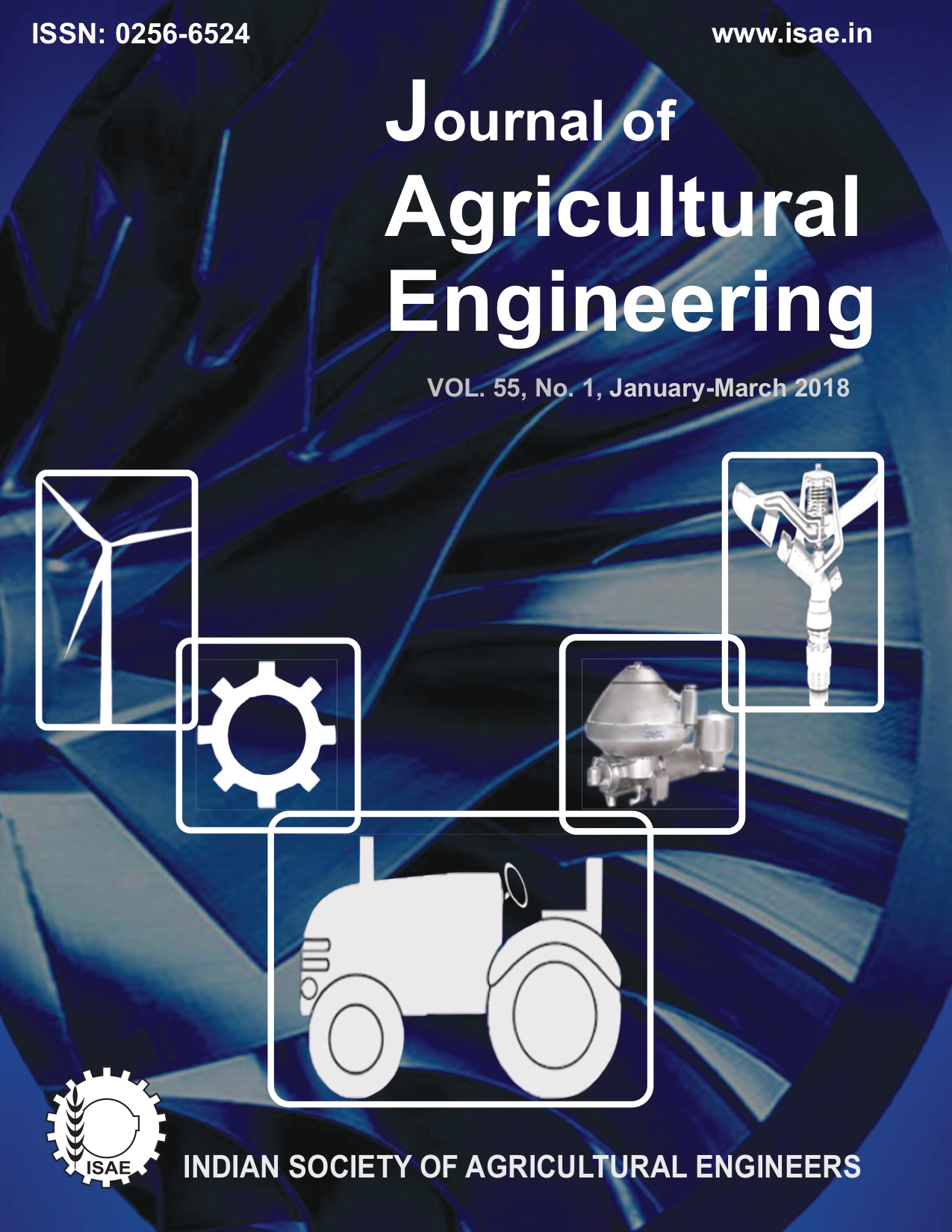Impact of Morphometric Parameters and Change in Land Use on Peak Runoff Rates of Pingalgarh Watershed Using Geospatial Techniques
DOI:
https://doi.org/10.52151/jae2018551.1648Keywords:
Watershed, drainage system, bifurcation ratio, cropping pattern, land use, runoffAbstract
Morphometric analysis of Pingalgarh watershed in Maharashtra state was carried out using remote sensing and GIS techniques for 1977 and 2016. Detailed drainage map was prepared from LISS-IV high resolution satellite image of 20th November 2016 to assess the present situation and from Geo-referenced toposheet on 1:50,000 scale for the year 1977 to bring out the past condition. These maps were used for morphometric analysis and also for runoff estimation. Low drainage density values indicated that the area was underlain by moderately impermeable sub-surface material. Circularity and elongation ratio showed that the watershed had elongated shape. Due to change in land use, the total stream length in the watershed had reduced. The low to moderate value of basin relief indicated gravity of water flow, moderate infiltration and runoff condition of the study area. The length of overland flow indicating the long flow path with moderate ground slope, reflecting the areas associated with moderate runoff and infiltration. Low values of relief are the characteristic features of less resistant rocks of the area. Due to change in land use and cropping pattern over a period of time, the time of concentration was reduced in the later stage resulting in increase in peak runoff rate.
References
Agarwal C S. 1998. Study of drainage pattern through aerial data in Naugarh area of Varanasi district, U.P. J. Indian Soc. Remote Sensing, 26 (4), 169-175.
CGWB. 2006. Dynamic groundwater resources of India (as on March 2004). Central Ground Water Board (CGWB), Ministry of Water Resource Government of India. New Delhi, pp.120.
CGWB. 2013. Ground water information- Parbhani district, Maharashtra, Central Ground Water Board (CGWB), Ministry of Water Resources, Government of India. Nagpur Division, 1-18.
Chopra R; Dhiman R D; Sharma P K. 2005. Morphometric analysis of sub-watersheds in Gurudaspur district, Punjab using remote sensing and GIS techniques. J. Indian Soc. Remote Sensing, 33 (4), 531-539.
Dwivedi S C. 2011. Morphometric analysis of sub watershed in bath area of Agra district using remote sensing and GIS techniques. XII ESRI India User Conf., Noida, India, 1-11
Horton R E. 1932. Drainage basin characteristics. Trans. Am. Geophys. Union, 13, 350-361.
Horton R E. 1045. Erosional development of streams and their drainage basin: Hydrophysical approach to quantitative morphology. Bull. Am. Geol. Soc., 56, 275-370.
Kumar H; Mittal H K; Singh R S; Purohit R C; Singh P K. 2007. Application of remote sensing and GIS in planning of soil and water conservation measures. J. Agric. Eng., 44(1), 79-81.
Nag S K. 1998. Morphometric analysis using remote sensing techniques in Chaka sub basin, Purulia district, West Bengal. J. Indian Soc. Remote Sensing, 26(1&2), 69-76.
Nautiyal M D. 1994. Morphometric analysis of drainage basin using aerial photographs : A case study of Kharikuli basin, Distirct Dehdradun, U.P. J. Indian Soc. Remote Sensing, 22 (4), 251-261.
Rudraiah M; Govindaiah S; Vittala S S. 2008. Morphometry using remote sensing and GIS techniques in the sub-basins of Kagna river basin, Gullburga District, Karnataka, India. J. Indian Soc. Remote Sensing, 36, 351-360.
Sarangi A; Rajput T B S; Rao A R. 2008. Geomorphological parameters based watershed sediment yield estimation. J. Agric. Eng., 45(1), 47-56.
Schumn S A. 1956. Evolution of drainage systems and slopes in badland at Perth Amboy, New Jersey. Geol. Soc. Am. Bull., 67, 597-646.
Sreedevi P D; Owais S; Khan H H; Ahmed S. 2009. Morphometric analysis of a watershed of South India using SRTM Data and GIS. J. Geol. Soc. India, 73. 543-552.
Sreenivasan G; Joshi A K; Krishna Murthy Y V N. 2010. Role of remote sensing and GIS in integrated watershed development. In: Proc. of National Symposium “The Application of Nuclear and Space Technologies for the Benefit of Farmers” organized by Consortium of Indian Farmers Associations (CIFA),17th January at Raipur (Chhatisgarh), 96-106.
Sreenivasan G; Krishnamurthy Y V N. 2017. Remote Sensing and GIS Application in Micro Level Planning. In: Geospatial Technologies in Land Resource Mapping, Monitoring and Management, Springer Publication, 207-315.
Wodeyar J K; Patil R; Puranaik S C. 2001. Geological, geomorphological and hydrogeological studies of Kandra Basin of Kolhapur district, Maharashtra. In: Proc. of National Seminar on Groundwater Resource, Department Of Geology, MLS University, Udaipur, 139-142.














